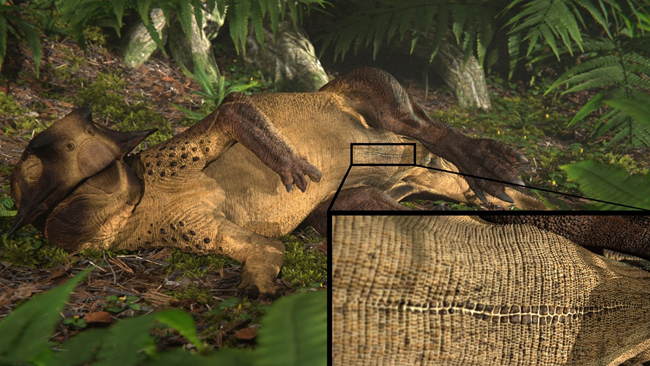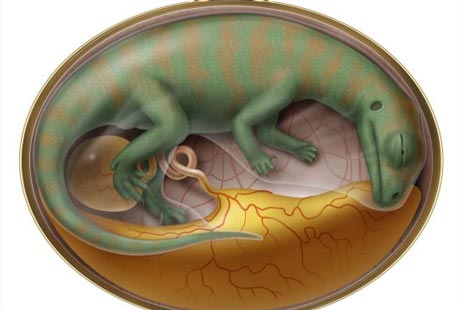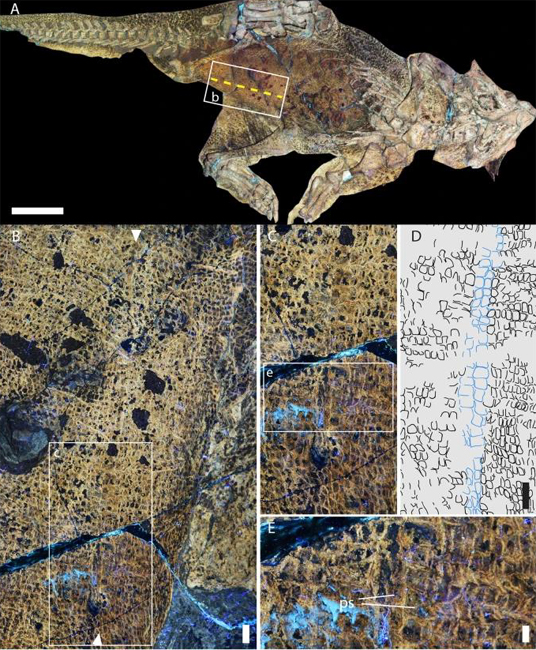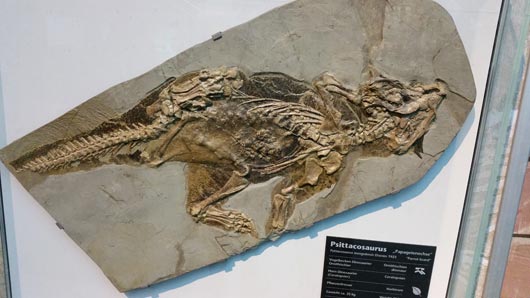Dinosaurs had “Belly Buttons” According to New Research
Researchers have identified the oldest preserved umbilical scar (umbilicus) in the fossilised remains of a dinosaur (Psittacosaurus). The equivalent of our “belly button”, this is the first dinosaur specimen to demonstrate an umbilical scar.

A life reconstruction of a resting Psittacosaurus. The umbilical scar is highlighted. Picture credit: Jagged Fang Designs.
Picture credit: Jagged Fang Designs
The “Belly Button” in Placental Mammals
Placental mammals such as humans (Homo sapiens) have an umbilical cord that connects the growing embryo to the placenta. It provides a supply line for nutrients, gaseous exchange and the removal of waste products. Our “belly button”, the navel, is the scar that is left when the last fragment of the umbilical detaches from the baby shortly after the cord has been cut.
Reptiles and living avian dinosaurs (birds) do not have a true umbilical cord. However, whilst inside the egg, the embryo’s abdomen is connected to the yolk sac, which provides the developing embryo with a food source. The umbilical scar (umbilicus), appears when the embryo detaches from the yolk sac and other membranes.
In most living reptiles and birds this umbilical scar persists for only a few days, although in some genera the scar can persist and be found in adult animals, the Rock pigeon (Columba livia) for example. Scales on the bellies of snakes, lizards and crocodilians often preserve faint traces of the umbilicus, it being marked by a subtle change in scale morphology and alignment.

An image of a Lufengosaurus embryo. An umbilical scar has been identified in a Psittacosaurus specimen. Picture credit: D. Mazierski.
Picture credit: D. Mazierski
The Remarkable Senckenberg Psittacosaurus
The researchers who included Dr Phil Bell (University of New England, New South Wales, Australia) and Dr Michael Pittman (The Chinese University of Hong Kong), subjected the superbly-preserved Senckenberg Psittacosaurus specimen (SMF R 4970) to examination under laser-stimulated fluorescence (LSF). Using this imaging technique, the team were able to identify the umbilical scar as a midline structure outlined by a row of paired scales on the abdomen.

Umbilical scar in Psittacosaurus SMF R 4970 under LSF. A Cropped image of Psittacosaurus sp. (SMF R 4970) showing just the skeleton and soft tissue outlines, with the umbilical scar highlighted by the dashed yellow line. B Close up of boxed region in (A) with the maximal anteroposterior extent of the umbilical scar indicated by arrowheads. Wrinkling forming irregular wavy creases in the integument can be seen on the far right on this image where the abdomen meets the inner thigh; C, D Close up of boxed region in (B) showing paired quadrangular scales (blue outline in D) delimiting the umbilicus. Transverse banding is visible in the remaining abdominal scales (black outlines in D). E Close up of paired quadrangular scales (ps). A clear line of interstitial tissue, delimiting the former scar, can be seen between the paired scales. Anterior is towards the top in (B–E). Scale bars equal 5 mm (B–D) and 2 mm (E). Picture credit: Bell et al.
Picture credit: Bell et al
Soft Tissue Preservation
The remarkable Senckenberg Psittacosaurus specimen preserves extensive soft tissues including skin, it has provided palaeontologists with a rare insight into the integumentary covering of an early member of the horned dinosaur lineage. The skeleton is so precious that no form of destructive bone histology was permitted, but by measuring the length of the thighbones (femora) of this fossil and comparing these measurements to the length of the thigh bones from other Psittacosaurus fossils, which had been subjected to ontogenetic study, the researchers concluded that the Senckenberg specimen was close to being sexually mature.
This suggests that the umbilicus was probably retained in psittacosaurids throughout their lives.
Whilst this is the first, definitive proof of an umbilical scar in the Dinosauria, it is not possible to infer from this study whether all dinosaurs retained the umbilicus into adulthood.

Psittacosaurus fossils on display at the Senckenberg Naturmuseum (Frankfurt). Picture credit: Everything Dinosaur.
Picture credit: Everything Dinosaur
The Everything Dinosaur website: Prehistoric Animal Models and Toys.
A Legal Debate Surrounding SMF R 4970
The Psittacosaurus sp. specimen (SMF R 4970) is on public display in the Dinosaurs Unlimited permanent exhibition at the Senckenberg Research Institute and Natural History Museum Frankfurt, Frankfurt, Germany. Team members at Everything Dinosaur have had the opportunity to view this remarkable fossil.
The legal ownership of this fossil is disputed and there have been attempts to have this specimen repatriated to China.
The scientific paper: “Oldest preserved umbilical scar reveals dinosaurs had “belly buttons” by Phil R. Bell, Christophe Hendrickx, Michael Pittman and Thomas G. Kaye published in BMC Biology.

